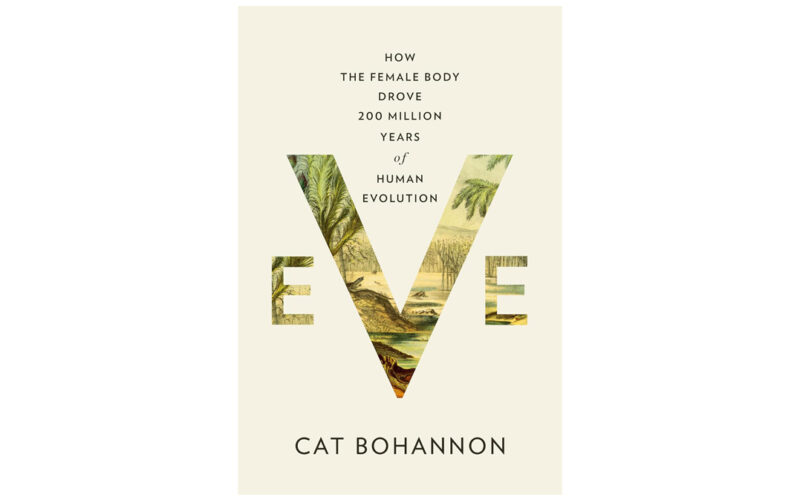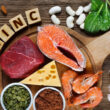Have you ever wondered why women live longer than men? Or if there’s really such a thing as the “female brain?” How about why women experience menopause or have a menstrual cycle? These questions are all explored in Cat Bohannon’s 2023 book Eve: How the Female Body Drove 200 Million Years of Human Evolution. Hailed by the New York Times as “an opinionated clapback against centuries of male-centric evolutionary history,” Eve traces various traits of the female body back to their evolutionary sources—all the way back to a diverse array of “Eves,” as it were—shedding new light on why women’s bodies are so different from men’s, all from the perspective of evolutionary biology.
While numerous fascinating sections in Eve gave me a greater insight into the inner workings of the female body and how they may have materialized over time, the greater message behind Eve is one many readers may not agree with or appreciate. In this book review, I weigh the good with the bad, and recommend whether to buy, borrow, or skip Eve.
To quote her LinkedIn bio, Cat Bohannon “is a researcher and author with a Ph.D. from Columbia University in the evolution of narrative and cognition.” While she does not have an explicit biology background, she does pull from the work of numerous scientists in her book and gladly gives credit where it’s due. Bohannon’s skill largely lies in her writing and researching abilities, as Eve is an extremely well-written read, with multiple narrative strands bringing the reader through a heavy amount of scientific research.
Who is the intended audience of Eve?
Due to its ease of reading, Eve is meant as a popular scientific book—meaning that it is for a lay audience of non-scientists. Even if you’re unfamiliar with the topics presented in the book, you’ll still come away with an increased understanding of evolutionary biology and female physiology. Eve will probably appeal to a mainly female audience (and Bohannon writes it as such), but there really is something in it for everyone.
What are the main content areas of Eve?
Eve begins with a lengthy introduction that gives readers a taste of what is to come, all centered on the question: why are women’s bodies so different from men’s? And the differences abound! For example, women have more body fat than men (because our developing babies in the womb use it as a primary source of nutrition, p. 12) and women even metabolize drugs more quickly than men (which has big implications for how doctors prescribe things like painkillers or anesthesia, p. 9). According to Bohannon, all of these traits of the female body can be traced back to different “Eves,” aka the different evolutionary origins of what makes us both human and women.
From there, the book is split up into nine chapters, each of which follows one evolutionary “Eve” of different bodily traits or aspects of womanhood. They are: milk (lactation), womb, perception, legs, tools, brain, voice, menopause, and love.
For example, the first chapter (“Milk”) follows a species called Morganucodon which lived 205 million years ago and is believed to be the first creature that ever lactated—in other words, the very first mammal. While this gerbil-like creature isn’t our direct evolutionary ancestor, Bohannon believes it can tell us a lot about why human women lactate. Interwoven with descriptions of this furry little “Eve” are answers to all the things you’d want to know about human lactation, like what colostrum is made up of (p. 36), and how babies personalize the nutrients they receive in breastmilk via their saliva (p. 45).
The rest of the chapters follow in a similar fashion, each presenting the reader with the “Eve” of that specific trait, and an exploration of how these traits came to fruition in the modern female body.
What are the strengths of Eve?
The most obvious strength of Eve is its wide-ranging research, with nearly 90 pages of bibliography that mostly consist of scientific research papers. Bohannon covers an extremely diverse field of topics, ranging from why women have a leg-up in athletic endurance but are vastly overpowered by men in pure strength and speed (p. 190), to how a mother’s brain rewires itself in the early postpartum days in order to care more properly for her infant and know who to trust in her community (p. 283).
Another point of interest in Eve are Bohannon’s discussions of how human females differ from females of other species in how we are built and how we operate. She includes vivid depictions of how uteri and ovaries are situated for humans and other species that also give live birth (p. 97-98), along with possible explanations for why some women have uteri that diverge from what is typical, such as in the case of a bicornuate or “heart-shaped” uterus.
Bohannon’s creative writing skills also shine throughout, as she weaves story narratives in with her research. A particular standout passage is at the beginning of the “Menopause” chapter, where she describes an old woman acting as a midwife for her granddaughter in prehistoric times (p. 338). Her description of how the wisdom of older women was key to the survival of a village (such as in the case of helping a younger woman going through a difficult breech birth) was quite moving, and a wonderful celebration of womanhood in all its stages.
Eve’s limitations or blindspots
Ideology clouds many of Bohannon’s arguments
While Bohannon is a gifted writer and researcher, she does have one glaring blindspot: her own ideology. This first example appears on page 4 of Eve, where Bohannon says that biological sex and gender identity are distinct from one another. If you do not agree with this, she writes, you are holding the belief of “gender essentialism” which is a “natural extension of sexism” and merely reduces men and women to, well, what makes them men and women (their bodies!).
These ideological themes continue throughout the book, as Bohannon asserts (for example) that “it’s clear that trans women are women” (p. 292), with little explanation to back up this statement. It’s odd that in a book about how women are inherently, biologically different from men, the author steadfastly clings to the ideological statement that biological men are women simply because they believe they are. To this end, Bohannon also completely ignores the entire field of research on gender-specific medicine, which makes it clear that appreciating and understanding the distinctions between males and females is essential to the practice of good medicine.
Pregnancy as unnatural and inherently dangerous
Another problematic aspect of Bohannon’s ideology are her views on pregnancy and abortion. Bohannon starts from the belief that human female bodies are “bad” at reproduction because “pregnancy is inherently dangerous” (p. 114). While there are numerous pregnancy complications that can spell danger for both a mother and her child, Bohannon’s negative view on how pregnancy affects a woman’s body is really quite extreme. Not only does this outlook eschew the fact that pregnancy is a normal part of life for most women, but it also ignores the fact that pregnancy itself can have health benefits for the mother. Treating pregnancy like an inherently dangerous disease rather than a natural aspect of womanhood leaves women feeling terrified at the prospect of being pregnant and giving birth, which only serves to raise maternal anxiety rates.
Not only this, but this viewpoint also leads Bohannon to a strident endorsement of abortion (without exceptions), as she sees abortion as inherently more safe than pregnancy (p. 405). (She makes no mention of the preborn child who loses his life in such a procedure.) Abortion is a form of “womb triumphalism” (p. 236) for Bohannon, as is hormonal birth control.
Inconsistency about whether sexual morality matters
Finally, the last chapter of Eve (called “Love”) is where Bohannon truly leaves behind science in favor of ideology. The entirety of “Love” hinges on the concept of sexism, and whether or not it has helped or hurt the evolution of humans. Interestingly, Bohannon never actually defines sexism, instead using it as an imprecise answer for anything she deems bad, such as having “sex rules;” (p. 407) i.e., norms for appropriate human sexual behavior. In fact, Bohannon sees “sex rules” as generally negative, eschewing any notion of moral rights and wrongs in the realm of human sexuality, but then (rightly) condemns child marriage as inherently immoral and damaging, without seeing the irony that “sex rules” are actually at play (appropriately so) in this particular instance (p. 413-414).
To sum up the “Love” chapter, Bohannon calls for more institutions that “combat the negative effects of sexism,” which explicitly includes expanding access to abortion and birth control (p. 433). I found this last point particularly disheartening and nonsensical, as it completely ignores the myriad ways birth control and abortion are detrimental to women’s health, and actually contribute to sexism. Bohannon also does not mention how abortion ends a human life, and seemingly supports abortion access without any barrier or exception.
The verdict: To buy, borrow, or skip Eve?
While I’d initially hoped to write that Eve could be read with an “eat the meat and spit out the bones” strategy, ultimately I found that the heavy-handedness of Bohannon’s ideology overpowered much of the good her book has to offer. As a result, I think most readers of Natural Womanhood will probably want to skip Eve, unless they’re prepared to sift through unsubstantiated opinions on topics like gender ideology, hormonal birth control, sexual morality, and abortion.
Eve would be a better, more interesting book if Bohannon had taken on these topics from a truly evidence-based perspective, acknowledging the harms inflicted on women by gender ideology, birth control, and abortion, instead of letting her ideological beliefs distort her vision to the point of seeing these things as good. Even better, it would have been refreshing to see Bohannon talk about how women are able to exercise control over their reproductive lives through the use of fertility awareness—a topic she doesn’t mention even once. Despite its flaws, however, Eve does offer a unique perspective on evolutionary biology and the female body that many readers may enjoy, so the book might be worth borrowing from the library if these topics are of special interest to you.








Thank you for the Pros and Cons of Eve…I have a degree in Health Science, A retired certified Doula, Childbirth Educator and Breastfeeding Instructor.. I do research on all things natural and unnatural in the above topics.
Women were designed for Childbirth and lactation..Everything about a woman’s body, even her arm is different from that of a man. His is a throwing arm, hers is a cradeling arm..Her breasts no mater her height is at the EXACT DISTANCE not too close or too far from her nursing infant so that the newborn can focus on her eyes..while feeding..That allows for new brainwaves to open up paths in both the mother and the baby.. So many things I could go on about.. that needs to be taught to women, by those who have experienced and studied and actually promoted to the benefit of not just women and their babies, but to everyone who learns to be in AWE of the FEMALE BODY..and the perfect design of both men and women in their interlocking possibilities for cooperating the the co-creation of another human being.. Rose Mary Danforth
Love this, Rose Mary! Thank you so much for sharing!